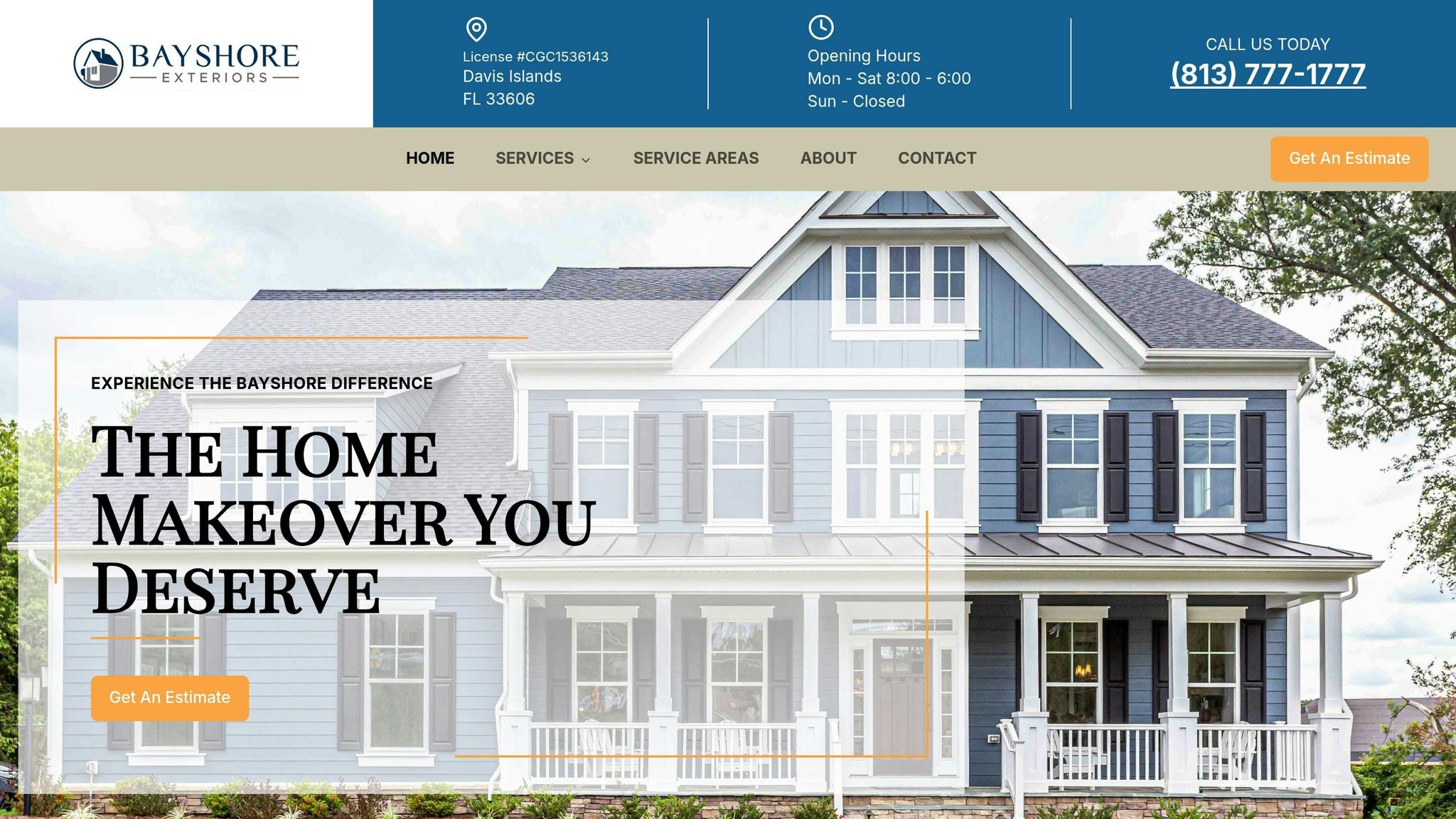


James Hardie Siding in High-Wind Areas: What to Know

Make an appointment
Get a Free Estimate Today
James Hardie Siding in High-Wind Areas: What to Know
James Hardie siding is a reliable option for homes in high-wind areas. Its fiber cement material resists wind speeds up to 157 mph, meets strict building codes like Miami-Dade County’s HVHZ standards, and provides protection against moisture, fire, and impact damage. However, proper installation by certified professionals is critical to ensure it performs as intended.
Key takeaways:
- Wind Resistance: Rated for Category 5 hurricane winds (157+ mph).
- Durability: Resists cracking, warping, and flying debris impact.
- Moisture & Fire Protection: FEMA-certified flood resistance and non-combustible.
- Installation: Requires professional expertise to meet local building codes.
If you're in a storm-prone region, James Hardie siding offers long-term protection and peace of mind when installed correctly.
iCyclone Storm Chaser Talks Durable Siding from James Hardie

James Hardie Siding Wind Resistance and Durability
James Hardie siding provides homeowners with a dependable option for enhancing storm protection.
Wind Resistance Ratings and Certifications
James Hardie siding is engineered to handle wind speeds of 157 mph or higher. This impressive rating goes beyond the requirements in many high-wind areas across the U.S. It has also passed the rigorous testing standards in Miami-Dade County, Florida - a region recognized for its strict building codes - earning approval for use in High Velocity Hurricane Zones (HVHZ).
Fiber Cement Material and Performance
The secret behind James Hardie siding's wind resistance lies in its fiber cement composition. This dense material is designed to resist lifting, curling, cracking, and denting, even under extreme wind conditions. Compared to traditional vinyl siding, fiber cement offers better durability, standing strong against cracking and denting during high winds. This durability ensures it meets the demands of tough building codes.
Building Code Requirements
James Hardie siding complies with strict building codes for high-wind areas. When installed following the manufacturer's guidelines, it provides homeowners with peace of mind, knowing their siding is built to withstand harsh wind conditions while meeting local safety standards.
Installation Methods for High-Wind Regions
Installing James Hardie siding in areas prone to high winds demands precision and adherence to specific guidelines. Using the right fasteners and following local building codes is essential to ensure the siding performs as intended.
Fastening Methods and Requirements
Wind-resistant installation of James Hardie siding starts with the use of fasteners approved by ICC-ES ESR-2290. These fasteners must be corrosion-resistant, such as galvanized or stainless steel, to handle harsh weather conditions. While James Hardie recommends blind nailing for a cleaner appearance, some local building codes require face nailing to provide extra hold against strong winds. In certain cases, the Pin Backs method may also be acceptable, depending on regional requirements.
Proper spacing between fasteners is equally important. Deviating from the recommended spacing can weaken the siding’s ability to withstand high winds. These guidelines highlight why it’s crucial to follow professional installation standards.
Why Professional Installation Matters
Installing siding in high-wind zones isn’t just about following the manufacturer’s instructions - it also means aligning with local building codes, which can vary. Professional installers understand these nuances and know when adjustments, like switching from blind nailing to face nailing, are necessary to meet wind load requirements. Their expertise ensures that every fastener is placed correctly, which minimizes the risk of siding damage during extreme weather conditions.
sbb-itb-85e0110
Benefits and Drawbacks of James Hardie Siding
When considering James Hardie siding for high-wind areas, it's important to weigh its strengths against the challenges of proper installation to ensure it performs as intended.
Benefits of James Hardie Siding
James Hardie siding is specifically designed to handle tough conditions, offering exceptional durability in high-wind areas. It boasts outstanding resistance to wind, fire, moisture, pests, and impacts, meeting rigorous regional standards.
One standout feature is its fire resistance. Hardie® fiber cement siding won't ignite when exposed to direct flames and doesn't add fuel to fires, making it a smart choice for regions prone to both high winds and wildfires.
Moisture resistance is another key advantage. Unlike wood siding, which can swell or crack when exposed to water, Hardie® siding is engineered to withstand rain, sleet, and snow. In a seven-day water saturation test, Hardie® fiber cement showed no visible swelling, while both engineered wood and cedar expanded significantly. It's even FEMA-certified as flood-resistant.
The material also excels in impact resistance. Its fiber cement composition makes it far more durable against cracking, denting, and hail impacts compared to vinyl siding. Additionally, it resists pests like termites and woodpeckers, ensuring long-term protection.
"Wood naturally absorbs water and swells. As a result, it can lead to a number of maintenance issues for the homeowner, including splitting and the development of cracks." - Lupe Olive, Senior Research Scientist, James Hardie
While these benefits are impressive, they depend heavily on proper installation to deliver peak performance.
Potential Drawbacks
Despite its many strengths, James Hardie siding has one critical requirement: certified professional installation. Achieving its high-wind durability and other benefits relies on correct fastening and sealing. Improper installation can compromise its performance, especially in extreme conditions. For this reason, hiring trained professionals is essential.
Pros and Cons Comparison Table
| Pros | Cons |
|---|---|
| Rated to withstand Category 5 hurricane wind speeds | Requires certified professional installation for best results |
| Approved for use in High Velocity Hurricane Zones | |
| Fire-resistant and does not contribute fuel to a fire | |
| FEMA-certified flood resistance | |
| Superior resistance to hail impacts | |
| Pest-resistant to termites and woodpeckers | |
| No visible swelling in moisture saturation tests |
Professional Services for High-Wind Area Siding
To ensure James Hardie siding performs as intended in high-wind areas, professional installation is a must. Properly installing this siding requires strict compliance with building codes and precise fastening techniques. The expertise of certified professionals is key to achieving the wind resistance that makes James Hardie siding such a reliable choice.
Why Choose Professional Experts
Hiring professional installers ensures your James Hardie siding is prepared to withstand extreme weather conditions. These experts are well-versed in the detailed requirements of local building codes, which are critical for proper performance. They follow the manufacturer's guidelines to the letter, using approved fastening and sealing methods that protect against water infiltration and maintain structural integrity during hurricanes and severe storms.
In areas with wind speeds exceeding 100 mph or for taller structures over 40 feet, professionals also know when additional engineering calculations are required to meet wind load standards. They ensure that all joints - vertical and horizontal - are properly sealed and protected using techniques such as caulking, battens, flashing, or shiplap, as dictated by code. Moreover, they ensure the fiber-cement siding complies with material standards like ASTM C1186, Type A. This level of precision and expertise is often beyond the reach of DIY efforts, making professional installation the smarter choice.
Local professionals bring these technical standards to life with the added benefit of community trust and proven service.
Bayshore Exteriors: Your Local Siding Experts

When it comes to high-wind installations, Bayshore Exteriors sets the bar high. As a certified James Hardie Elite Contractor, they’ve undergone rigorous training and met strict performance standards established by James Hardie. This certification underscores their expertise in handling these advanced siding solutions.
What truly sets Bayshore Exteriors apart is their deep understanding of Florida’s unique climate and architectural demands. They explain:
"As proud long-term members of the Tampa Bay community, we have a deep understanding of the unique challenges and opportunities that come with Florida's climate and architectural styles. We leverage this knowledge to tailor our solutions to meet your specific needs and preferences."
Their process combines expert consulting, meticulous planning, and precise installation using premium materials. Whether it’s a custom siding makeover, new construction, or a full exterior renovation, they ensure every project meets the high standards required for wind performance.
Their commitment to quality is further reflected in their Lifetime Workmanship Warranty and their twelve consecutive Super Service Awards from ANGI. With a strong Google rating based on 212 reviews, Bayshore Exteriors has built a reputation for delivering consistent, professional results.
"As certified experts, we're committed to elevating your home's value and appearance through meticulous siding installations, complete exterior renovations, and personalized service."
For homeowners in high-wind areas, Bayshore Exteriors offers not just installation expertise but also the local knowledge needed to optimize James Hardie siding for Florida’s demanding weather. From Tampa Bay to surrounding regions, they ensure your siding is ready to perform when it matters most.
Conclusion: Protecting Your Home with James Hardie Siding
James Hardie fiber cement siding offers a dependable shield against harsh weather. Made from a mix of cement, sand, and cellulose, it’s built to withstand tough conditions and deliver long-lasting durability.
This siding meets top wind resistance and flood standards, with FEMA certifying Hardie® siding as flood-resistant. It’s designed to resist swelling, cracking, and warping - even after being submerged in water for seven days. Backed by warranties and tested under ASTM C1185 standards, it’s proven to handle water, heat, and freeze cycles reliably.
However, the strength of the material is only part of the equation. Proper installation is critical to ensuring James Hardie siding performs at its best. Certified professionals ensure all fastening and sealing requirements are met, which is especially important in areas prone to high winds.
For homeowners in hurricane-prone areas, James Hardie siding offers peace of mind. Its ability to resist wind-driven debris, hail, and water infiltration helps preserve both the structure and appearance of your home, even after intense storms. Routine inspections and timely repairs further enhance its longevity, protecting your home for years to come.
When paired with expert installation, these features provide unmatched protection for your home. Ready to safeguard your property? Reach out to Bayshore Exteriors for professional James Hardie siding installation.
FAQs
Is James Hardie siding a good choice for homes in high-wind areas?
Yes, James Hardie siding is a great choice for homes in areas prone to high winds. It’s built to endure extreme weather, including wind speeds reaching those of a Category 5 hurricane. Made from tough fiber cement, it resists cracking, warping, and damage from impacts, offering a sturdier alternative to lighter materials like vinyl siding.
Beyond its strength, James Hardie siding is designed to manage pressure changes and withstand debris impacts often seen in storm-heavy regions. It’s a durable, low-maintenance option that not only protects your home but also boosts its curb appeal.
What are the installation requirements for James Hardie siding to ensure it performs well in high-wind areas?
To make sure James Hardie siding complies with building codes and holds up in high-wind areas, it's important to stick to the manufacturer's instructions. Use corrosion-resistant fasteners that meet ICC-ES ESR-2290 standards, and install them following the spacing guidelines in the Wind Load Tables. Pair this with proper framing and a reliable water-resistive barrier to add extra protection and ensure long-term durability. For region-specific wind exposure details, always refer to the installation manual for precise guidance.
Why is it important to hire a professional for James Hardie siding installation, and what should homeowners consider when choosing an installer?
When it comes to James Hardie siding installation, hiring a professional is crucial to getting the job done right. Proper installation ensures the siding performs at its best - offering top-notch durability, resistance to weather, and a long lifespan. This is especially important in areas prone to high winds, where mistakes can lead to issues like loose panels or moisture problems.
To find the right installer, look for a contractor who is both licensed and insured, with proven experience working with fiber cement siding. Check their customer reviews and ask for references to gauge their reliability and skill. Ideally, the installer should have specific expertise with James Hardie products and follow all manufacturer guidelines and industry standards to deliver a secure, lasting result.